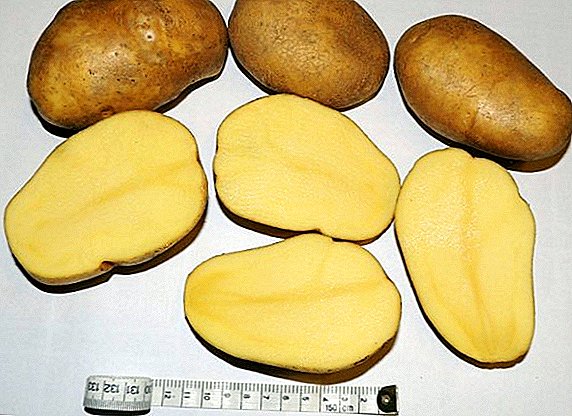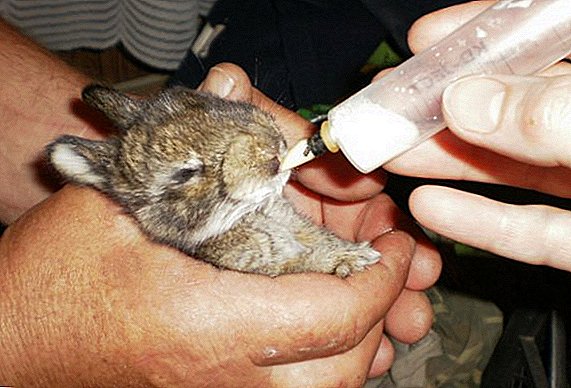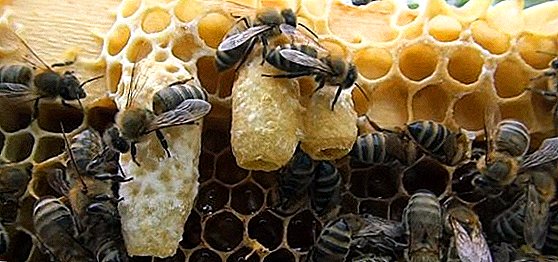 For a long time, a honeybee has been serving man as a source of healthful products: honey, wax, propolis, etc. In addition, its role is great as a natural pollinator of plants. One of the key events in the life of a bee family is its swarming therefore, it is important to understand the features of this process, as well as to know how to avoid bees swarming.
For a long time, a honeybee has been serving man as a source of healthful products: honey, wax, propolis, etc. In addition, its role is great as a natural pollinator of plants. One of the key events in the life of a bee family is its swarming therefore, it is important to understand the features of this process, as well as to know how to avoid bees swarming.
Swarming bees as a natural phenomenon
Under certain conditions, the bee family is divided, and one of its parts leaves the hive. This process of natural reproduction of a family is called swarming. It looks like this: on a clear, warm, windless day a real stream of insects rushes from the hive, which form a rather dense cloud. The swarm has an average mass of 1.5 kg, but five-kilogram swarms can form. Further, a swarm in the form of a cluster hangs on bushes or trees and remains in this form, waiting for messages of reconnaissance bees looking for new housing. With positive results of exploration, the swarm moves to the dwelling found. 
Did you know? A bee not loaded with nectar can reach a speed of 65 km / h, and a strong bee family during a season flies an average distance equal to the distance from the Earth to the Moon.
Signs of
There are a number of signs that indicate the early onset of family swarming:
- the uterus is no longer fed;
- the uterus dramatically reduces egg laying, while decreasing in size and acquiring the ability to fly;
- insects in clusters gather on the walls of the hive and barely fly beyond the nectar;
- construction of honeycombs stops;
- numerous drone broods appear;
- insects gnaw a notch;
- the buzz of insects intensifies.
Before you start creating an apiary, learn the features of beekeeping for beginners.

Causes of swarming
In beekeeping, the process of swarming itself, as a rule, is an indicator of the well-being of the bee family and can be caused by various reasons. But sometimes it happens that the bees fly away due to extremely unfavorable living conditions. In addition, the swarming process beekeepers themselves can initiate. Let's see why bees are swarming.
Overcrowding
Overpopulation is the most common reason for starting a process. In this case, the extended family does not have enough space for storing nectar, the uterus has nowhere to lay eggs, and in addition, too many insects gather around the uterus and become cramped in the nest.
Reproductive swarming
It is believed that this type of bees swarming arises because of an excess of nurse bees serving only the uterus. The unemployed nurses begin to build swarm mothers. When these queen cells are sealed, the old queen as part of the swarm leaves the hive.
Coriander, chestnut, buckwheat, hawthorn, espartsetovy, rapeseed, linden and phacelia - very tasty and healthy varieties of honey, which are collected from the depths of nature itself.

Did you know? In the Far East, during the flowering of linden, there were cases when the weight gain of the control hives reached 33 kg in one day.
Other reasons
In addition to the above, there are other reasons forcing bee families to swarm. So, among beekeepers, it is widely believed that families living in hives located in the sun swarm more often than families from shaded hives. This is due to overheating of the hives. In addition, bees may begin to swarm due to stuffiness.
There is also the so-called forced swarming, which indicate the trouble of the bee family. In this case, the family leaves the hive not for the purpose of reproduction, but in an attempt to survive. At the same time, there are no insects in the hive. Such migration occurs in Neroi time - either in early spring or in autumn, when the bribe is still or no longer. 
Sometimes beekeepers themselves initiate the swarming of bees to settle new hives. The advantage of the artificial process over the natural is that the beekeeper gets the family he needs at the right time, in optimal conditions and in the right quantities. The process is called in various ways: by covering the uterus, by shaping the layers, by dividing the family.
Read the description of the breed of bees and the differences between them.
How to determine the time of swarming?
Usually, bees swarm in the month of May or in early June, when the weather is stable and warm. However, it is not uncommon for swarms to form in July and August. Signs of swarming were listed above, but using the control box will help you more accurately determine when the bees begin to swarm. In one part of the frame there is a strip of honeycomb, the other remains empty. The frame is periodically checked.
If the bees rebuild the honeycomb, then swarming is not expected. If the honeycombs are not rebuilt, but at the same time they laid the queen mothers (this feature is optional), the bee family is preparing for swarming and the beekeeper has time to stop it. 
Important! The swarm is ready to fly out 8-10 days after the mother liquor is inoculated. It occurs in warm, sunny, windless weather.
How to avoid swarming?
Swarming, if it is not controlled by a beekeeper, is perceived negatively, as you can simply lose the bees. In addition, the process may not be limited to one swarm. It happens that bee families swarm continuously, and each subsequent swarm is weaker than the first. Naturally, in this case, the products from the bees should not be expected. Therefore, the swarming of bees often try to be prevented as a harmful phenomenon, and for this purpose beekeepers use a number of methods.
Honey is far from the only value that a person receives due to bees. Beekeeping products such as pollen, bee venom, wax, propolis, podmor, drone milk have also been applied.
Uterine wing pruning
This method is quite old and tried. To avoid unwanted migration of bees, some beekeepers cut the wings of the uterus. In addition, trimming the wing allows you to determine the age of the uterus. For example, in an odd-numbered year, the left wing is trimmed, and on an even year, the right. The wing is trimmed with scissors, about one third is removed. The uterus thus treated is unable to take off, the already formed swarm returns to the hive. 
Important! Experiments were conducted to determine whether the trimming of the wings affects the productivity of the bee colony. As a result, it was concluded that this procedure does not affect productivity.
Close the taped grate
If the hive is divided into bodies, then the whole brood, except for the frame with the queen bee, can be transferred to the upper body and separated by its dividing grid from the main body in which the bee family is located. In this case, the main body of the main body must also be closed with a grid. After that, the upper part of the hive is supplemented with honeycombs, and the lower part with frameworks with a wax. Thus, insects will be engaged in the construction of a new vorschina, while constantly in contact with the uterus. In a couple of weeks, when the swarm of a family goes out by itself, the grid should be removed.
Pick up print brood
Another reliable way to control bees swarming the use of multiple hives. In the presence of such a hive, sealed brood should be transferred to its upper body, and the uterus and open brood should be left in place, on the lower floor. Free space should be filled with honeycombs and wrinkles. This method will avoid overpopulation of the family. Free space forms in the hive, in the uterus - for egg-laying, and in bees to collect nectar. After the upper building is filled with honey, experienced beekeepers recommend putting a store on it.
If you want honey productivity to increase by 3 times, read how to breed bees in multibody hives.

Rearrange hives in places
In this case, a hive with a swarm need to be moved away and put another one on this place, preliminarily staffing it with 6-8 frames, necessarily with a wrinkle on the sides. Two frames with light sushi need to be filled with sweet syrup. One frame with bee eggs, if possible from the most promising family, should be installed in the middle of the hive.
This should be done before the period of swarming bees. On top of this new hive, you must install a plywood frame with a diaphragm. It is necessary to make an inlet - exactly in form, as the upper notch of the blown hive, so as not to disorient the bees. Further, on this frame it is necessary to put an old beehive, and then all the flight bees will move from the old house to a new one and lay fresh fistulous queen cells. The family will be divided, but the swarm of the bees will be extinguished. 
The reverse family reunification takes place in July, during the period of the main honey collection and the active laying of eggs by both uterus. To do this, preferably on a quiet evening, the family from the upper hive is sprinkled with sugar water infused on the mint leaves, after which the upper structure (hive with diaphragm) is removed. Then, the same syrup sprinkles the bees from the lower hive. Next, a newspaper is laid on the framework, having previously made several holes in it with a needle, and the old hive is placed on a new one, but without a diaphragm. After these manipulations in the lower hive should open the upper entrance. By morning, both families will unite into one, and at the height of the honey harvest a full-fledged bee colony will work.
Chess
This method was developed by Canadian specialist Walter Wright. The problem of swarming is solved as follows - above the nest before swarming of bees should be installed (in a mixed way, through one) a frame with sealed honey and a frame with rebuilt honeycombs. This method is good because do not bother bee's nest. This operation disorients the insects, convincing them that the time for swarming has not yet come.
Conclusion
Although the swarming of bees is a natural breeding process, it can lead to the loss of bees and a decrease in honey collection. Therefore, it is important for the beekeeper to be able to control him, and if necessary, take steps to prevent it.












